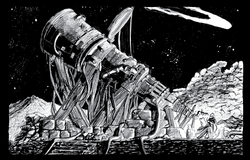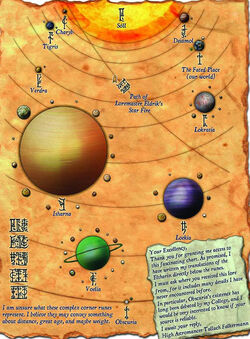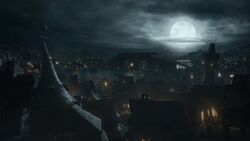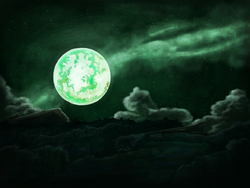"They came in their silvery vessels. Impossibly powerful. Mysterious. Then our world was frozen, huge and empty. Life was simple, barbaric, without language, knowledge or civilisation. They changed us. They changed everything. We only know them as the Old Ones. They had the power to move worlds, to bring them closer or to move them away from the eternal heat of the sun. That's what they did, bringing our cold globe back to life. But this unbalanced the other worlds, because everything is connected. Then they moved them too, forming an impossible harmony among the spheres, a perfection that can still be seen today by observing the heavens. See the five children of Asuryan: Charyb, the closest to the sun, only takes 80 days to go around; while Deiamol takes 133 and a third of days; Tigris, 200; our world, 400; and Verdra, 800. Compare this to the five Councilors: Lokratia takes 1,600 days, four of our years; Isharna, 10 years; Loekia, 30 years; Voelia, 150 years; and blessed by the Old Ones -- is an impressive sight even after so many millennia."

A telescope used to examine the stars.
Astronomy is the scientific study of the stars, the other planets, the heavens and the Known World's place within the broader cosmos. It is a primary pursuit for the wizards of the Celestial College in the Empire.[4c]
Below can be found a brief overview of many of the heavenly bodies seen in the skies of the Known World that consume the interest and study of astronomers.
Heavenly Bodies of the Solar System

Andrew Law's unpublished map of the solar system of the Known World.[1a]
Primary
In the star chamber of Ytzel Cho, it is shown that the Known World's solar system dwells within a spiral galaxy. The star chamber is also able to determine the appearance of Morrslieb in the sky down to the day.[4d] The sun of the solar system containing the mortal world is called Söll,[10a] which shares the name of Wissenland's traditional god of the sun.
Planets
Children of Asuryan
The star system of the Known World is comprised of ten planets in total. The first five worlds by orbital distance from the sun of Söll that comprise the inner system, known as "the children of Asuryan" to the Elves, include:
- Charyb - The closest planet to the sun, Söll; it makes one revolution around Söll every 80 days.[1a]
- Deiamol - Deiamol is called "the Burning World." It is described as possessing a deep red surface dotted with countless interlocking circles. It is the second planet from the sun,[4b] and is slightly smaller than Charyb.[4d] It possesses one moon.[1a]
- Tigris - Tigris revolves around the sun once every 200 days. It it the third planet in the system.[4b] It has two moons.[1a]
- "The Fated Place" (Known World) - The "Fated Place" is the name given by the Lizardmen and their Old One creators to the mortal world; it revolves around the sun every 400 days. Two moons orbit the Known World, the natural satellite Mannslieb and an unnatural moon, Morrslieb, born from a massive fragment of viridian warpstone that was flung into orbit of the world after the collapse of the Polar Gates initiated the Great Catastrophe that first brought Chaos into the world. It was to this world that the Old Ones first came in their silvery ships. It was a far colder planet when those starfarers first arrived; through their incredible understanding of arcane artifice and the technologies available to them, they moved the world closer to its sun, dramatically warming its climate and making it more hospitable for the mortal races they would create upon it, including the Slann, Lizardmen, Elves, Dwarfs and Men.[1a] The Daemon Prince Be'lakor claimed to have named the planet "Mallus"[15].
- Verdra - The fifth planet of the system is described as a green sphere that possesses visible continents. It makes one revolution around the sun every 800 days.[4a] It possesses one moon.
The Councillors
The last five worlds of the outer system are called "the Councillors" and include:
- Lokratia - Lokratia, the sixth world of the system, is a planet whose surface is covered with meteor scars. It makes one revolution around the sun every 1600 days. It is described by astronomers as being ash-grey in colour, with orange lines stretched across its surface.[4a] It has seven moons.[1a]
- Isharna - Isharna is the seventh planet to orbit the sun and is described as "a mass of hot gasses" that is "striped with red and orange." Its orbital period around the sun is 4,000 days. It has thirteen moons.[1a]
- Loekia - The eighth planet, Loekia, has an orbital period of 12,000 days. It has six moons.[1a]
- Voelia - The ninth planet from the sun, Voelia, takes an incredible 60,000 days to make one revolution around the sun. It has fourteen moons.[1a]
- Obscuria - Obscuria, the tenth and most distant world in the system from the sun, is described as being deathly pale apart from three bruised smudges, a smattering of tiny black pinpricks, and covered with ice. Its very existence is disputed in the Empire and deduced only from theoretical arguments (though according to Bartolomi Kereveld, other scholars only dispute is existence if they don't understand calculus!).[4a] With that said, the Celestial College of wizards has always known Obscuria was "somewhere" out in the void, largely due to what Kereveld called a "doppler effect" that it makes in the magical field surrounding the solar system. Until Kereveld's expedition to Lustria was made, the Celestial College had never been able to accurately calculate its ellipse.[4b] It has one moon.[1a]
Moons of the World

The white moon of the Known World, Mannslieb, as seen from the surface.
- Mannslieb - The Known World's natural moon, as opposed to its companion in the sky Morrslieb, which was brought into being by the unnatural events of the Great Catastrophe. Also known as the "white moon," Mannslieb keeps a regular 25-day rotational cycle around the world, from one full phase to another.[1]

- Morrslieb - Morrslieb is the second green moon of the mortal world, and the dark twin of Mannslieb. It has an erratic cycle, unpredictably appearing smaller or larger in the sky. In times of disaster, some claim to see a mocking, twisted face appear on its surface. Morrslieb heralds great misfortune to many cultures when it appears closer to the world. Morrslieb is actually a massive fragment of warpstone, condensed and solidified magical energy, that was flung from the Realm of Chaos following the collapse of the Old Ones' Polar Gates and the coming of Chaos to the world in the Great Catastrophe.[1]
Fixed Stars
Fixed stars are those celestial bodies that do not move across the sky, in contrast to comets and planets.
- Polar Star[3a]
- Bale Orb - This star is only visible with witchsight and only during certain convergences.[11a]
Notable Constellations
Constellations are patterns that form symbols or pictures to those who see them by connecting the stars in certain ways.
- The Fang of the Wolf[3a]
- Great Hammer- The Great Hammer becomes hard to distinguish when Morrslieb is full.[9a]
- Kerr, the Slayer of Fiends[12a]
- The Great Wolf[16a]
- Scales of Verena[16a]
- Myrmidion Spear[16a]
Imperial Zodiac
Many inhabitants of the Empire believe that the stars or constellations one is born under have a hand in determining one's fate.[2a] The Imperial Zodiac is a system of twenty star signs believed to have influence on the development of personality traits and an individual's character.[6a] The degree to which people believe in the power of the zodiac varies. The very wealthy and very superstitious might have an astrologer at hand to calculate their child's natal chart within hours of their birth.[6b]
Other Cultures
The Bretonnian adventurer Florin d'Artaud mentioned not being able to see "The Mill", "The Griffin" or "The Lady's Veil" in the night sky over Lustria's eastern coast. It is unclear if these constellations are Bretonnian names for star signs already mentioned, or if they are entirely separate ones. However, even in Lustria, one constellation -- "The Serpent" -- can still be seen as a bright star (its eye), while beneath it, trails of stars form the fangs. The constellation then spirals over and into the horizon.[4a]
"Aenarion's Swordbelt" is the Asur name of a constellation visible in Ulthuan's night sky.[3a] It is not known if it corresponds to one of the heavenly constellations seen in the Old World.
The Skaven acknowledge thirteen major constellations, including the "Big Rat," the "Drowned Rat," the "Little Rat," the "Black Rat," the "Cornered Rat," the "Pink Rat" and "King Mouse."[7a] It is not known if these also correspond to one of the constellations known by Human scholars.
The Lizardmen of Lustria use the alignment of the celestial bodies to track time.[13a] Many of these, such as the "Itzl Star" or the "Fire Stars" are unknown to outsiders.[13a]
Comets and Meteors
- Comet of Cassandora - The Comet of Cassandora is sometimes described as a "meteorite" which is summoned via magic.
- Great Maw - The Great Maw is speculated to have originated in a warpstone comet which impacted the Known World, becoming a god of eternal hunger and tormenting the Ogres, turning a once green and fertile area of the Far East into a colossal crater.
- Loremaster Eldrik's Star Fire - A celestial body whose trajectory has been calculated.[1a]
- Twin Tailed Comet - The Twin Tailed Comet is a portent of important/dangerous times, noted by all the races and cultures of the Known World, but especially revered by the Human and Lizardmen followers of the gods Sigmar and Sotek, respectively.
Notable Astronomers
- Celestial College - The Celestial College of the Imperial Colleges of Magic in Altdorf is the foremost institution of astronomy as well as of astrology in the Old World. They regularly publish the Leitner Ephemeris, an annual volume that contains daily trajectories of all of the heavenly bodies and constellations for the entire year.[6b]
- Frenzo Badolphus - Badolphus is a Tilean prince, scientist and astronomer from the city of Ducieso, located in the Trantine Hills near the city-state of Trantio.[5a]
Trivia
Andrew Law (AKA Hapimeses) created a map of the Known World's solar system for Tome of Salvation, a Warhammer Fantasy Roleplay 2nd Edition supplement, but it was cut from publication. Andrew used the Black Library novel The Burning Shore by Robert Earl as a key reference to create this map, as it named the entire solar system and gave some details.[1a][4]
Sources
- 1: Warhammer Fantasy Roleplay 2nd Edition: Tome of Salvation (RPG)
- 1a: Andrew Law's unpublished map of the Warhammer World's solar system
- 2: Warhammer Fantasy Roleplay 2nd Edition: The WFRP Companion (RPG)
- 2a: pp. 46-52
- 3: Beastslayer (Novel) by William King
- 3a: Ch. 6: "A Hero's Welcome"
- 4: The Burning Shore (Novel) by Robert Earl
- 5: Warhammer Monthly Comic 13
- 5a: Dreams of Lustria by Dan Abnett and David Pugh
- 6: Warhammer Fantasy Roleplay 4th Edition: Archives of the Empire Vol II (RPG)
- 7: The Black Plague: Dead Winter (Novel) by C.L. Werner
- 7a: Prologue
- 8: Sword of Caledor (Novel) by William King
- 8a: Ch. 15
- 9: Storm of Magic: Razumov's Tomb (Novel) by Darius Hinks
- 9a: Ch. 1
- 10: Warhammer Fantasy Roleplay 4th Edition: Enemy in Shadows (RPG)
- 10a: pg. 149
- 11: Van Horstmann (Novel) by Ben Counter
- 11a: Ch. 11
- 12: The End Times Vol. 1 - Nagash (8th Edition)
- 12a: p. 28
- 13 Warhammer Armies: Lizardmen (8th Edition)
- 13a: pg. 26
- 14: Warhammer Armies: Lizardmen (7th Edition)
- 14a: pg. 24
- 15: Total War: Warhammer III (PC Game)
- 16: Heldenhammer (Novel) by Graham McNeill
- 16a: Ch. 4
